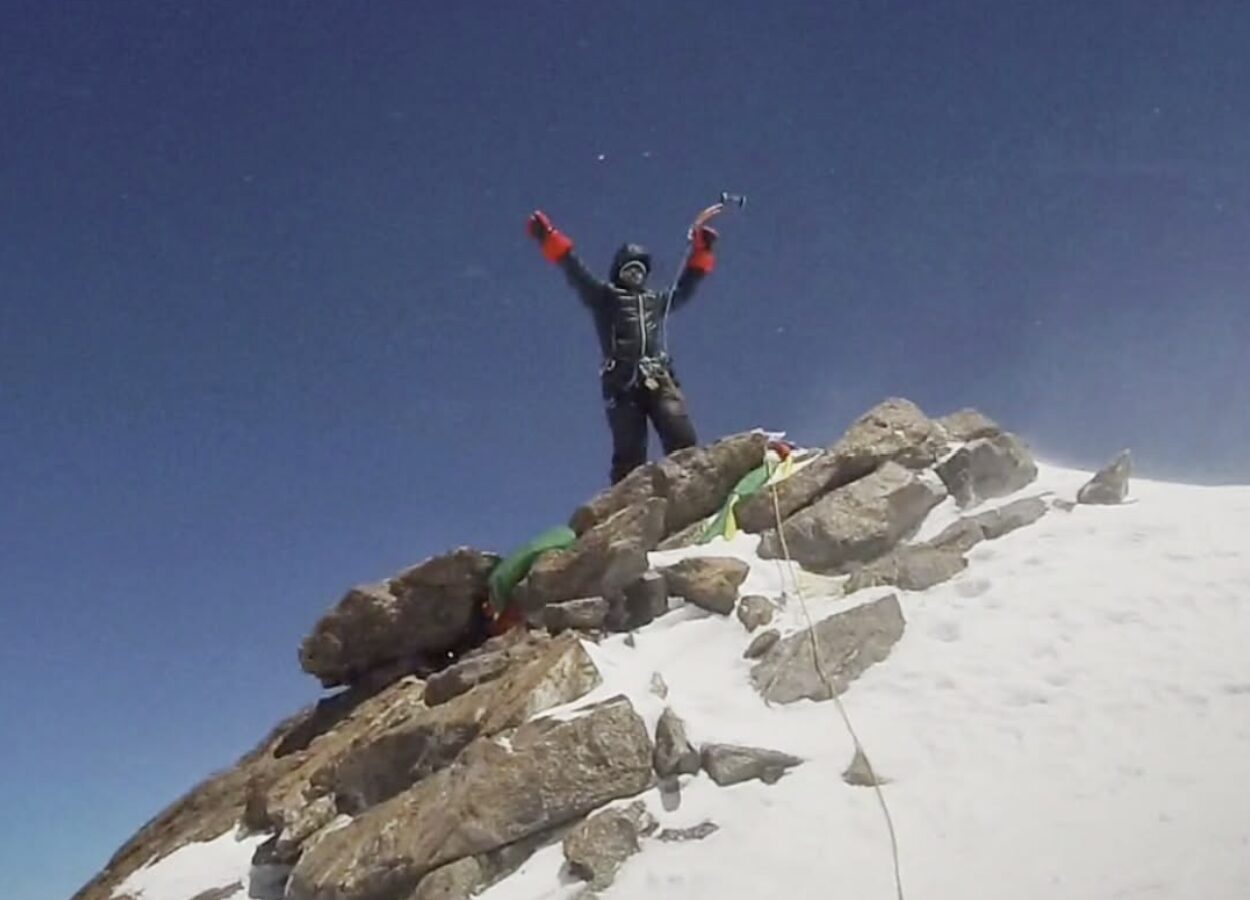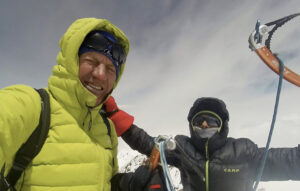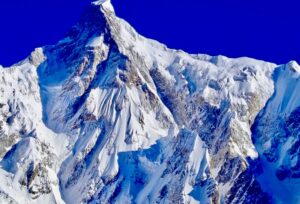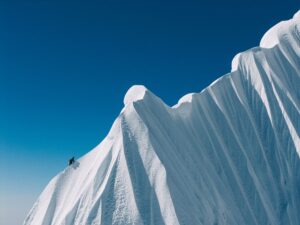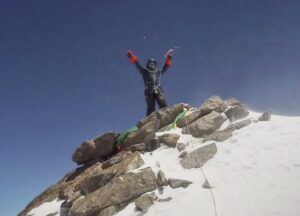Denis Urubko of Russia and Maria Cardell of Spain have finally shared details of their new route on Nanga Parbat.
The couple took it easy after climbing from the Diamir side; in a very Urubko-style move, they remained an extra week in Base Camp, enjoying the solitude of the mountain. It was only yesterday, as they returned to Skardu, that they checked their emails and shared details of their line.

María Cardell and Denis Urubko celebrate their new route on Nanga Parbat. Photo: Instagram
Difficult, exposed, lonely
They opened their route between July 6 and July 10. It combined varied terrain, with ice, mixed rock, snow, and a crevassed glacier, Urubko told Mountain.ru. He explained that the route is technically difficult and exposed to avalanches and rockfall in some sections.
In addition, the climbers went up in far from ideal weather conditions, with storms every afternoon and winds as high as 90kmph.
“We didn’t use other people’s ropes or tracks,” Urubko told Mouintain.ru. “There were no breakdowns, injuries, or illnesses.”
Indeed, they were the only people on that side of the mountain and, when the climb took place, they were the only people anywhere on the mountain. This season, summits on the normal route (the Kinshoffer) occurred on July 3 and July 4. David Goettler of Germany and French climbers Tiphaine Duperier and Boris Langenstein summited from the Rupal side on June 24.
You can read Urubko and Cardell’s full report on Mountain.ru in Russian.
Crossing previous lines
Shortly after Urubko published a topo of the route, some members of the climbing community shared comments on social media pointing to the similarity of the line to previously opened routes. In particular, some pointed out that the route seems to coincide with a line opened in 2009 by Gerfried Goeschl of Austria and Louis Rousseau of Canada.

A post by @dominobb on X on July 21.
Urubko did note in his report that their route intersects the Austrian-Canadian route at around 6,600-6,800m. “But [our route] continues along the ridge, while the other team went along the glacier,” he explained.
Asked by ExplorersWeb, Cardell confirmed the information from Pakistan: “Our route does not step on the Goeschl/Rousseau route at any section; both lines cross, but then the Austrian-Canadian route continues along the glacier and our line follows the ridge,” Cardell said.
Cardell noted that she spoke to Rousseau before the expedition, and the Canadian climber shared information about his 2009 expedition alongside Goeschl (who later perished while attempting winter Gasherbrum I). Therefore, Urubko and Cardell were well aware of the location of the 2009 route.
“For a person not familiar with the terrain, it may look like it is the same line, but the distance between both routes is wide; everything else is speculation,” Cardell said.
Many teams have climbed Nanga Parbat from its Diamir side. Crossing and/or following small sections with previous lines doesn’t make Urubko and Cardell’s feat any less impressive.
Female first
The achievement is especially significant for Maria “Pipi” Cardell. She is a ski patroller by profession and a member of Spain’s elite female alpinism team. According to Urubko, Cardell is the first female climber to summit an 8,000’er via a new route opened in alpine style.
Urubko and Cardell took turns to lead during the climb, and in some sections they simul-climbed (progressed roped up at the same time, without belaying one another).
“It is an elegant and logical line, technical to a point that took me to my physical and mental limits,” Cardell wrote. “I am not euphoric after the achievement. On the contrary, I feel calm…all the past efforts fit like pieces of a puzzle. Our dream is complete.”
A solid pair
Cardell was enthusiastic in her praise for Urubko. “It is surreal to see how confidently he climbs in extremely complex terrain at high altitude,” she said. “His intuition is based on wide experience, and his ability to obsessively focus becomes our guarantee of survival. [Added to his] supernatural strength at 8,000m, this makes him unique.”

Denis Urubko with Maria Cardell. Photo: Denis Urubko
“Denis [Urubko] and I have been climbing together for ten years,” Cardell wrote on Instagram. “We have been working and training all this time to get ready and, someday, achieve this dream.”
Together, they have opened new routes, alpine style, on Chapayev (in the Tien Shan) and Ushba (in the Caucasus). They attempted a new route on Gasherbrum II in 2019, but Cardell had to drop out after injuring her back. Urubko soloed the route, naming it “Honeymoon” in tribute to Cardell. They also attempted a new route on Gasherbrum I, but eventually climbed via the normal route because of bad conditions.
Through the years, Urubko has been a methodical and very tough coach for iron-willed Cardell. “It has been training and more training…drytooling, climbing, running to exhaustion, learning new techniques and adopting new habits, don’t drink, cry often, feeling utterly happy at every little step ahead, hesitating until finally managing to believe in myself and, never, never surrendering,” Cardell said.
Forget-me-not
The pair has named the new route Незабудка (Nezabudka), meaning “the unforgettable girl.” It is the Russian name of a flower known in English as the forget-me-not or scorpion grass. Under the Latin scientific name Myosotis and with some 60 variants, it is a small mountain plant that grows delicate flowers, generally blue, soon after the snow melts in alpine ecosystems. It is the official flower of Alaska. The relatively low altitude of Nanga Parbat’s lower slopes allows grass and flowers to grow in Base Camp, especially during this relatively warm season.
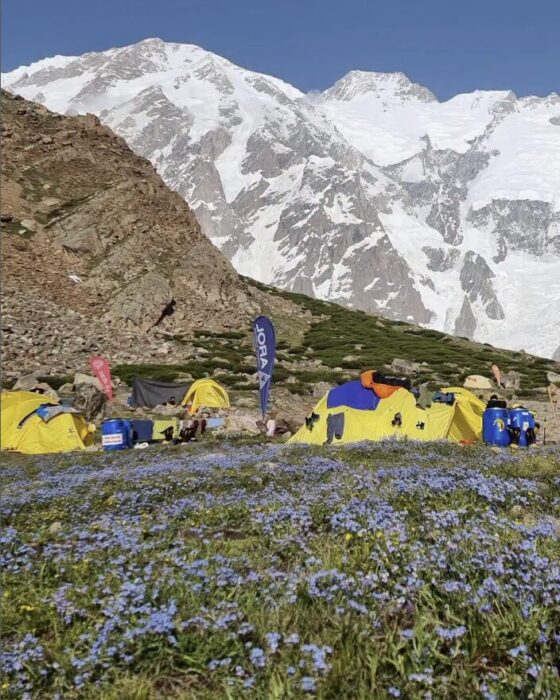
Nanga Parbat’s Base Camp under the Kinshoffer route, blooming with forget-me-nots. Photo: Allie Pepper
